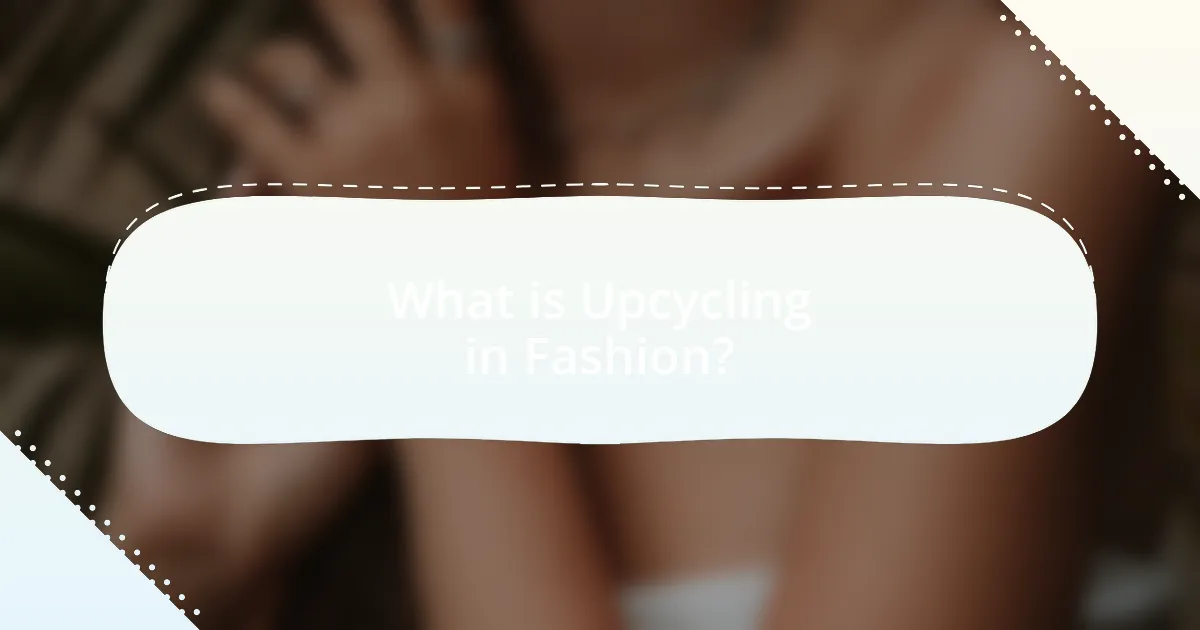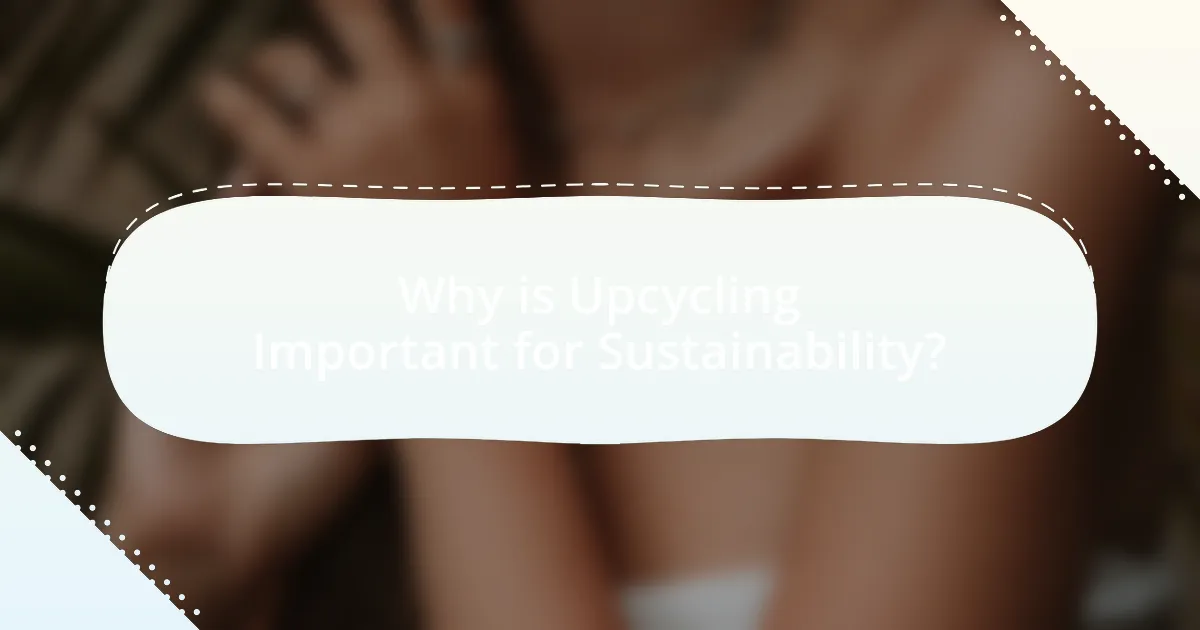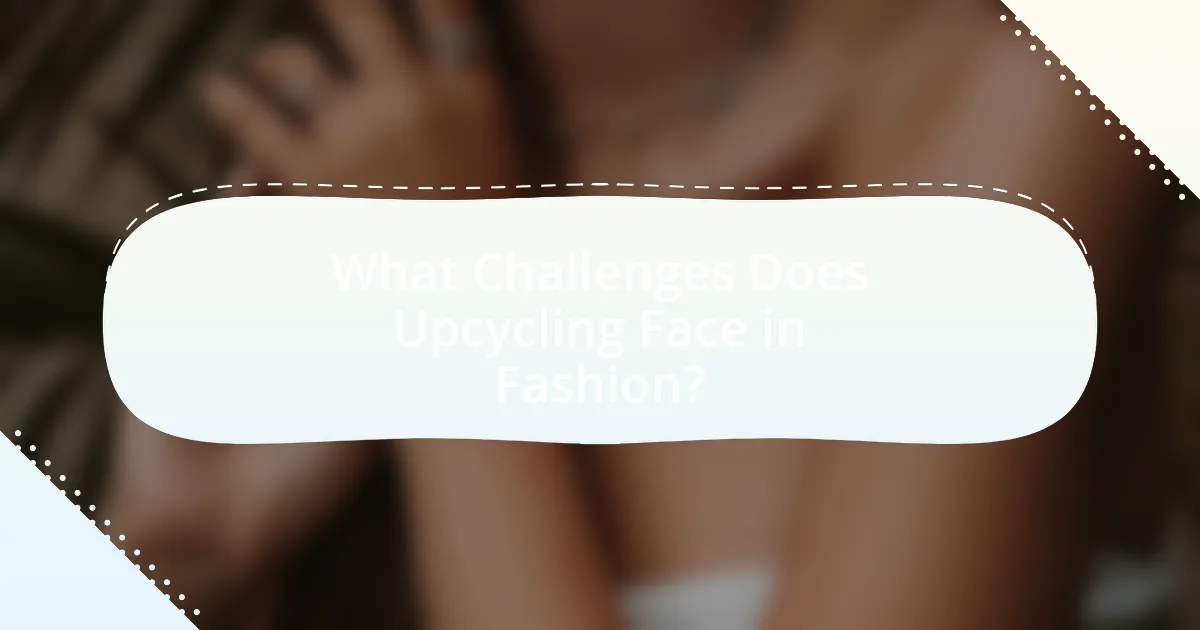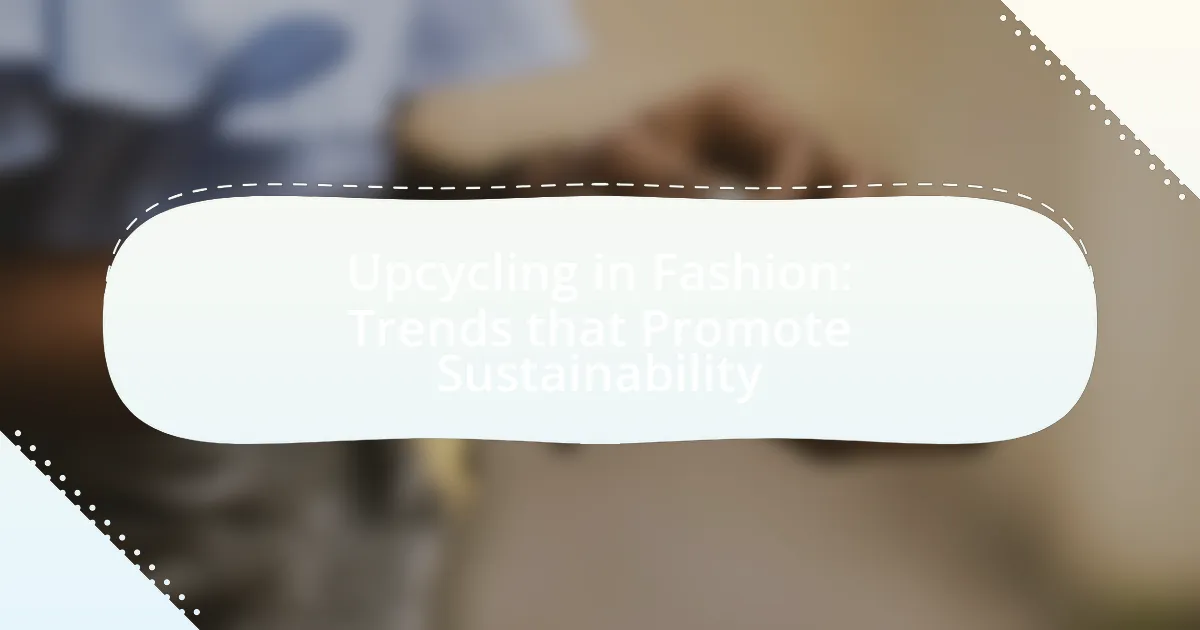Upcycling in fashion refers to the process of transforming discarded or unused materials into new clothing or accessories, thereby extending the lifecycle of textiles and reducing waste. This practice is crucial for sustainability, as it minimizes the environmental impact of textile production, which generates over 92 million tons of waste annually. The article explores the differences between upcycling and traditional recycling, the processes involved in upcycling fashion items, and its significance in conserving natural resources. It also highlights key trends, consumer roles, and the challenges faced by the industry, while providing insights into how designers and consumers can actively participate in promoting upcycled fashion.

What is Upcycling in Fashion?
Upcycling in fashion is the process of transforming discarded or unused materials into new clothing or accessories, thereby extending the lifecycle of textiles and reducing waste. This practice not only minimizes the environmental impact associated with textile production but also encourages creativity and innovation in design. According to a report by the Ellen MacArthur Foundation, the fashion industry is responsible for 92 million tons of waste annually, highlighting the importance of upcycling as a sustainable solution.
How does upcycling differ from traditional recycling?
Upcycling differs from traditional recycling in that upcycling transforms waste materials into new products of higher quality or value, while traditional recycling breaks down materials to create new raw materials. Upcycling often involves creative processes that enhance the aesthetic or functional aspects of the original item, such as turning old clothing into fashionable accessories. In contrast, traditional recycling typically focuses on the reprocessing of materials like plastics or metals into their base forms for manufacturing. This distinction highlights that upcycling not only reduces waste but also promotes innovation and sustainability in fashion by encouraging the reuse of existing materials in a more valuable way.
What processes are involved in upcycling fashion items?
Upcycling fashion items involves several key processes: collection, design, transformation, and finishing. First, collection entails sourcing discarded or unused clothing and materials, which can include thrifted items or fabric scraps. Next, design involves conceptualizing new uses for these materials, often requiring creativity to envision how they can be repurposed. The transformation process includes physically altering the items, such as sewing, dyeing, or assembling components to create a new product. Finally, finishing involves adding details like embellishments or final touches to enhance the aesthetic appeal. These processes collectively contribute to reducing waste and promoting sustainability in the fashion industry.
Why is upcycling considered a sustainable practice?
Upcycling is considered a sustainable practice because it extends the lifecycle of materials, reducing waste and the demand for new resources. By transforming discarded items into new products, upcycling minimizes landfill contributions and conserves energy and raw materials needed for manufacturing. For instance, a study by the Ellen MacArthur Foundation highlights that upcycling can significantly lower carbon emissions associated with production processes, thereby contributing to a circular economy.
What are the key trends in upcycling within the fashion industry?
Key trends in upcycling within the fashion industry include the increasing use of vintage materials, the rise of DIY fashion, and collaborations between brands and artists. The fashion industry is increasingly sourcing vintage fabrics and garments to create new pieces, which reduces waste and promotes sustainability. DIY fashion has gained popularity as consumers seek to personalize their clothing, often using second-hand items to create unique designs. Additionally, collaborations between established brands and independent artists or designers are becoming more common, allowing for innovative upcycled collections that highlight creativity and sustainability. These trends reflect a broader movement towards environmentally conscious practices in fashion, as evidenced by the growing number of brands committing to sustainable sourcing and production methods.
How are designers incorporating upcycled materials into their collections?
Designers are incorporating upcycled materials into their collections by creatively repurposing discarded textiles, plastic waste, and other materials to create new garments and accessories. This practice not only reduces waste but also promotes sustainability in the fashion industry. For instance, brands like Reformation and Patagonia utilize surplus fabrics and post-consumer waste, transforming them into stylish, eco-friendly products. According to a 2021 report by the Ellen MacArthur Foundation, the fashion industry could reduce its environmental impact significantly by adopting upcycling practices, highlighting the growing trend among designers to embrace this innovative approach.
What role do consumers play in the upcycling trend?
Consumers play a crucial role in the upcycling trend by driving demand for sustainable products and influencing brands to adopt eco-friendly practices. Their purchasing choices reflect a growing preference for items that are repurposed or creatively transformed from waste materials, which encourages companies to innovate and offer upcycled goods. According to a 2021 survey by McKinsey, 66% of consumers expressed a willingness to pay more for sustainable brands, highlighting their impact on market trends and corporate responsibility. This consumer behavior not only supports the upcycling movement but also fosters a culture of sustainability within the fashion industry.

Why is Upcycling Important for Sustainability?
Upcycling is important for sustainability because it reduces waste and minimizes the demand for new resources. By transforming discarded materials into new products, upcycling diverts waste from landfills, which is crucial as landfills are a significant source of greenhouse gas emissions. According to the Environmental Protection Agency, in 2018, approximately 292.4 million tons of trash were generated in the United States, highlighting the urgent need for waste reduction strategies. Upcycling also conserves energy and raw materials, as it often requires less energy than producing new items from virgin materials. This practice not only promotes environmental conservation but also encourages a circular economy, where products are reused and repurposed, ultimately leading to a more sustainable future.
How does upcycling contribute to reducing waste in the fashion industry?
Upcycling significantly reduces waste in the fashion industry by transforming discarded materials into new products, thereby diverting them from landfills. This process not only minimizes the demand for new raw materials but also decreases the environmental impact associated with textile production. According to a report by the Ellen MacArthur Foundation, the fashion industry generates over 92 million tons of waste annually, and upcycling can effectively mitigate this by repurposing existing textiles. By extending the lifecycle of materials, upcycling contributes to a circular economy, promoting sustainability and reducing the overall carbon footprint of fashion.
What statistics highlight the impact of fashion waste?
Fashion waste significantly contributes to environmental degradation, with approximately 92 million tons of textile waste generated globally each year. This waste results in about 1.2 billion tons of greenhouse gas emissions annually, equivalent to the emissions produced by more than 300 million cars. Furthermore, the fashion industry is responsible for 20% of global wastewater, primarily due to dyeing processes. These statistics underscore the urgent need for sustainable practices, such as upcycling, to mitigate the adverse effects of fashion waste on the environment.
How does upcycling help in conserving natural resources?
Upcycling helps in conserving natural resources by repurposing materials that would otherwise be discarded, thereby reducing the need for new raw materials. This process minimizes the extraction of resources such as water, energy, and raw materials, which are typically required for manufacturing new products. For instance, a study by the Ellen MacArthur Foundation highlights that upcycling can significantly decrease the carbon footprint associated with production, as it often requires less energy compared to traditional manufacturing processes. By extending the lifecycle of existing materials, upcycling effectively reduces waste and lessens the environmental impact associated with resource extraction and production.
What are the environmental benefits of upcycling in fashion?
Upcycling in fashion significantly reduces waste and conserves resources. By transforming discarded materials into new products, upcycling diverts textiles from landfills, where they contribute to pollution and greenhouse gas emissions. According to the Environmental Protection Agency, in 2018, 11.3 million tons of textile waste were generated in the U.S. alone, highlighting the urgent need for sustainable practices. Additionally, upcycling minimizes the demand for new raw materials, thereby reducing water usage and energy consumption associated with the production of new fabrics. For instance, producing one cotton t-shirt requires approximately 2,700 liters of water; upcycling helps mitigate this resource depletion. Overall, upcycling in fashion promotes a circular economy, fostering sustainability and reducing the environmental footprint of the fashion industry.
How does upcycling reduce carbon footprints?
Upcycling reduces carbon footprints by repurposing materials that would otherwise contribute to waste and greenhouse gas emissions. When products are upcycled, the need for new raw materials is diminished, which in turn lowers the energy consumption and emissions associated with manufacturing processes. For instance, a study by the Ellen MacArthur Foundation indicates that upcycling can reduce carbon emissions by up to 70% compared to producing new items from virgin materials. This significant reduction occurs because upcycling often requires less energy and fewer resources, thereby minimizing the overall environmental impact.
What are the long-term ecological impacts of upcycling practices?
Upcycling practices have significant long-term ecological impacts, primarily by reducing waste and conserving resources. By transforming discarded materials into new products, upcycling minimizes landfill contributions, which accounted for approximately 292.4 million tons of waste in the United States in 2018, according to the Environmental Protection Agency. This reduction in waste leads to lower greenhouse gas emissions associated with waste decomposition and incineration. Additionally, upcycling decreases the demand for new raw materials, thereby conserving natural resources and reducing the environmental footprint of production processes. For instance, producing recycled materials typically requires less energy compared to manufacturing from virgin resources, which can lead to a decrease in overall energy consumption and associated emissions. Overall, the long-term ecological benefits of upcycling include waste reduction, resource conservation, and lower carbon emissions, contributing to a more sustainable environment.

What Challenges Does Upcycling Face in Fashion?
Upcycling in fashion faces several challenges, including limited consumer awareness, inconsistent quality of materials, and scalability issues. Limited consumer awareness hinders the growth of upcycled fashion, as many consumers are not familiar with its benefits or availability. Inconsistent quality arises from the diverse sources of materials, which can affect the final product’s durability and appeal. Scalability issues occur because upcycling often relies on small-scale operations, making it difficult to meet larger market demands while maintaining sustainable practices. These challenges collectively impede the widespread adoption of upcycling in the fashion industry.
What are the common misconceptions about upcycled fashion?
Common misconceptions about upcycled fashion include the belief that it is of lower quality, that it is only for niche markets, and that it lacks creativity. Many people assume that upcycled items are inferior because they are made from discarded materials; however, numerous designers create high-quality, stylish pieces from upcycled fabrics, demonstrating that sustainability can coexist with luxury. Additionally, upcycled fashion is often perceived as catering only to a specific audience, but it has gained mainstream popularity, with major brands incorporating upcycled elements into their collections. Lastly, the notion that upcycled fashion lacks creativity is false, as many designers showcase innovative techniques and artistic designs, transforming waste into unique fashion statements.
How do these misconceptions affect consumer perceptions?
Misconceptions about upcycling in fashion negatively affect consumer perceptions by leading to skepticism regarding the quality and value of upcycled products. For instance, consumers may believe that upcycled items are inferior or less fashionable compared to new products, which can deter them from purchasing. Research indicates that 70% of consumers associate sustainability with lower quality, as highlighted in a study by the Ellen MacArthur Foundation. This perception can hinder the growth of the upcycling market, as consumers may prioritize traditional fashion options over sustainable alternatives.
What challenges do designers face when sourcing materials for upcycling?
Designers face several challenges when sourcing materials for upcycling, primarily including limited availability, inconsistent quality, and logistical difficulties. Limited availability arises because upcycled materials often depend on local waste streams, which can be unpredictable and vary by region. Inconsistent quality is a significant issue, as the condition of discarded materials can differ greatly, affecting the final product’s durability and aesthetic. Logistical difficulties include the need for efficient collection and storage systems, which can complicate the sourcing process and increase costs. These challenges hinder the scalability of upcycling initiatives in the fashion industry, making it essential for designers to develop innovative strategies to overcome them.
How can the fashion industry overcome barriers to upcycling?
The fashion industry can overcome barriers to upcycling by implementing innovative design practices, enhancing consumer education, and fostering collaboration across the supply chain. Innovative design practices, such as modular clothing and adaptable garments, allow for easier transformation of existing materials into new products, thus reducing waste. Consumer education initiatives can raise awareness about the benefits of upcycling, encouraging more sustainable purchasing decisions; for instance, studies show that informed consumers are 60% more likely to choose upcycled products. Collaboration among brands, manufacturers, and recycling facilities can streamline processes and create a more efficient system for sourcing and processing materials, as evidenced by successful partnerships like the Ellen MacArthur Foundation’s initiatives, which have demonstrated significant reductions in textile waste through collective efforts.
What innovative solutions are being implemented to promote upcycling?
Innovative solutions promoting upcycling include the use of technology to facilitate the transformation of waste materials into new products. For instance, companies are employing digital design tools and 3D printing to create fashion items from discarded textiles, which reduces waste and resource consumption. Additionally, collaborative platforms are emerging where designers and consumers can share ideas and resources for upcycling, fostering a community-driven approach to sustainability. Research indicates that brands utilizing these methods have seen a significant increase in consumer engagement and brand loyalty, highlighting the effectiveness of these innovative strategies in the fashion industry.
How can collaboration between brands enhance upcycling efforts?
Collaboration between brands can significantly enhance upcycling efforts by pooling resources, expertise, and customer bases to create innovative solutions for waste reduction. When brands work together, they can share technologies and processes that improve the efficiency of upcycling, such as advanced recycling techniques or design strategies that make it easier to repurpose materials. For instance, partnerships between fashion brands and textile manufacturers have led to the development of new fabrics made from recycled materials, which not only reduces waste but also attracts environmentally conscious consumers. Additionally, collaborative marketing campaigns can raise awareness about upcycling initiatives, thereby increasing consumer engagement and participation. This collective approach can lead to a more substantial impact on sustainability in the fashion industry, as evidenced by successful collaborations like the one between Adidas and Parley for the Oceans, which transformed ocean plastic into high-performance sportswear.
What practical steps can consumers take to support upcycling in fashion?
Consumers can support upcycling in fashion by purchasing second-hand clothing and products made from upcycled materials. This practice reduces waste and encourages brands to adopt sustainable methods. According to a report by ThredUp, the second-hand market is projected to reach $64 billion by 2024, indicating a growing consumer preference for sustainable fashion choices. Additionally, consumers can participate in clothing swaps or upcycling workshops, which foster community engagement and creativity while promoting the reuse of materials. By actively choosing to buy from brands that prioritize upcycling, consumers can drive demand for sustainable practices in the fashion industry.
How can individuals incorporate upcycled fashion into their wardrobes?
Individuals can incorporate upcycled fashion into their wardrobes by actively seeking out clothing and accessories made from repurposed materials. This can be achieved through shopping at thrift stores, participating in clothing swaps, or purchasing from brands that specialize in upcycled products. According to a report by the Ellen MacArthur Foundation, the fashion industry is responsible for significant waste, and upcycling helps reduce this by extending the life cycle of garments. By choosing upcycled items, individuals not only contribute to sustainability but also often find unique pieces that reflect their personal style.
What resources are available for learning about upcycling techniques?
Online platforms such as YouTube, Skillshare, and Udemy offer a variety of courses and tutorials focused on upcycling techniques. These resources provide step-by-step guides and visual demonstrations, making it easier for learners to grasp the concepts. Additionally, books like “Upcycling: Create Beautiful Things with the Stuff You Already Have” by Danny Seo and “The Upcycle: Beyond Sustainability—Designing for Abundance” by William McDonough and Michael Braungart offer in-depth insights and practical projects. Furthermore, websites like Pinterest and blogs dedicated to sustainable fashion showcase numerous DIY projects and ideas for upcycling, allowing users to explore creative possibilities.

Leave a Reply